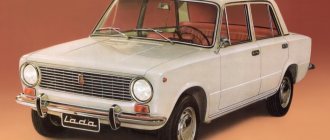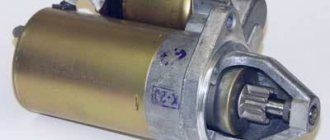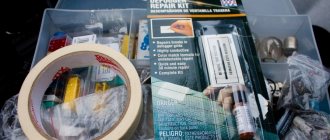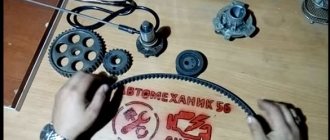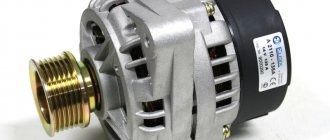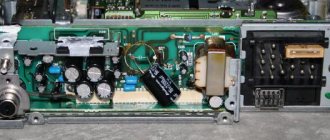We have repeatedly touched on the history of the creation of the first-born of the Volzhsky Automobile Plant and the reasons for choosing the Italian model (for example, in ZR No. 10, 2007), and now we are not talking about that. Let's try to understand engineering and sort out the main elements and design solutions of Italian and Soviet cars.
The Fiat 124 is a typical Italian design: a combination of advanced solutions, such as disc brakes, with a rather archaic lower engine. The main task of Soviet engineers was to adapt the design to the capabilities of domestic industry and, of course, to our operating conditions.
The Fiat 124 is a typical Italian design: a combination of advanced solutions, such as disc brakes, with a rather archaic lower engine. The main task of Soviet engineers was to adapt the design to the capabilities of domestic industry and, of course, to our operating conditions.
The first Zhiguli VAZ-2101 is based on the Fiat 124, which became the European Car of the Year in 1966. The choice of prototype for a Soviet car was largely determined by price, and the Fiat 124 was quite modern and, most importantly, a simple and practical car. In addition, the classic layout with rear-wheel drive was clearer to the leadership of the Soviet automobile industry, and therefore nicer than the front-wheel drive. And easier to repair. Let us list the changes that are not detectable with the naked eye, but important. The synchronizers in the gearbox have been strengthened. The clutch diameter was increased: 200 mm instead of 182 for Fiat. We did this, rightly believing that the quality of the Soviet linings would be unstable and that we would have to skid more often in our “directions.” | |
The front suspension of the VAZ-2101 has not been structurally changed compared to the Italian prototype. However, almost all of its elements, including levers and ball joint pins, were strengthened. |
Rear disc brakes were abandoned in favor of drum brakes. On our dirty roads, the rear discs wore out too much. On the VAZ-2101, each of the separate brake circuits has its own reservoir for brake fluid - for ease of repair and maintenance. The Italian model has a single tank. |
Instead of the Italian spring rear suspension with three bars and a front stabilizer, they used a different one, more modern at that time - with five bars. By the way, the Italians also used this scheme, but on the sports version of the Fiat 124 Spider. | |
Basic information
Experts say that the VAZ-2101 is a modernized version of the Fiat-124. This is because the Fiat manufacturer only produced the 124 until 1974. After this year, our domestic manufacturer, the Volzhsky Automobile Plant, modernized the VAZ-2101 car to fit the Fiat-124. The previous VAZ-2101 model differed in appearance:
- a round mirror was installed on the wing;
- there was a floor-mounted gas pedal inside the car;
- on the dashboard there are narrow indicator windows with many recesses;
- The deflectors of the ventilation system are made in the form of “ears”.
The re-equipment of this car was caused by the requirements of modern times: car owners wanted simplicity and easy maintainability.
Was the original Fiat better than a penny?
We are sure that many motorists think that the VAZ-2101 car was simply copied from the Fiat-124 car model. This was done in order to establish mass production of VAZ cars as an alternative to Volga and Moskvich cars. But in fact, with a detailed comparison of the first Zhiguli model, you begin to understand how different our Russian “kopek” is from the original 124 Fiat.
In the Soviet years, our state tried to find a car basis on the basis of which it would be possible to create an affordable family car in the country, which could be produced in some city, which would allow the state to support this locality with cash income that would come from mass production cars. Among other things, such a search for a concept was as follows: the car had to be exported abroad. In addition, one of the main criteria was the following: such a car must be strong and reliable in order to withstand harsh climatic conditions and bad roads in the country, which in those days were quite common even in large cities of the vast Soviet homeland.
Fortunately for us, in the 60s the country of Italy was ready to sell its cars and ideas to anyone. As a result, the leadership of our country agreed with the Italians on the supply of equipment for the production of passenger cars under the VAZ brand based on the popular Fiat-124 car at that time. At the request of our country, Italian specialists, together with our engineers and designers, almost completely redesigned the project of the 124th Fiat model. Also, specialists personally came to the plant in Togliatti to set up and configure the equipment and also to teach the employees of the new automobile enterprise to produce products that they could later be proud of.
Reference: The Fiat-124 car was developed in the mid-60s by the Italian. The car was first presented to the public in 1966. In 1967, the Fiat 124 won the “Best European Car of the Year” competition. Judging by the reviews of critics and auto experts, the car was decent and of high quality. The only thing is that the design of the model was somewhat old-fashioned.
It is worth noting here that the leadership of our country has been looking for a suitable option for a long time, and precisely on the basis of some European car, to begin producing a Soviet car accessible to the people. Many options were considered, but due to the quality of Soviet roads, many good cars were crossed off the list for production, since the design of many European cars, and even in large numbers, could not withstand our harsh operating conditions.
Ultimately, the country's authorities settled on the Italian Fiat, which best met our Soviet needs. After signing an agreement with, our country acquired a license for mass production of Fiat-124 cars. This is how the people of the USSR saw the first model of the Zhiguli, that is, the VAZ-2101 (the export name of the car is LADA 1200).
Information about Fiat 124
According to generally accepted information, Fiat-124 is the general name of a whole family of passenger cars that were produced by the company of the same name from Italy from 1966 to 1982.
Main technical characteristics of this vehicle:
- Engine – in-line, four-cylinder.
- Transmission - four-speed, mechanical type.
- The body layout is front-engine with rear-wheel drive.
- Weight and dimensions:
- length – 4042 mm;
- width – 1625 mm;
- height – 1420 mm;
- wheelbase – 2420 mm;
- weight – 855-950 kg.
Information certificate about VAZ-2101
The VAZ-2101 passenger car is popularly called “Zhiguli”. According to its characteristics, this is a small-class car, which has rear-wheel drive and a sedan-type body (like a Fiat 124). This model was produced from 1970 to 1988.
General technical characteristics of the VAZ-2101:
- Engines VAZ-2101 – 21011.
- The transmission is four-speed.
- Body:
- four-door;
- with a front-engine, rear-wheel drive layout.
- Mass-dimensional:
- length – 4073 mm;
- width – 1611 mm;
- height – 1382 mm;
- wheelbase – 2424 mm;
- weight – 955 kg.
This is one of the best domestically produced passenger cars, having received the International Golden Mercury Award (1972).
Trowel.zh.rf
Want to know everything
We have already discussed which Soviet cars were in demand abroad, and now a very popular topic is how our Zhiguli came to be.
Critics of the domestic auto industry, who criticize it for borrowing, often lack understanding of how difficult it is not only to create a car from scratch, but even to make a “local” version of a finished model provided by a partner. Everyone knows that the VAZ-2101 has Italian roots and is an almost exact copy of the Fiat 124. The key word here is “almost”!
Refining a foreign car for harsh Soviet conditions was by no means limited to replacing nameplates, as one might think. Behind this word stood many years of work by testers and design engineers. A book could be written about the transformation of Fiat into Zhiguli, and within the framework of the article we will present several interesting facts from this story.
In the USSR of the “pre-Zhiguli” era, a personal (as they said then, private) car was more exotic than commonplace. It was not just a matter of price: the operation of the car was fraught with considerable difficulties, and it itself was too small to appear in every Soviet yard.
In the mid-sixties, the country's top party leadership decided to implement its own “people's car” project, but not a Soviet design, but a licensed one. And not because “there were no brains in the country of atom and space”: a machine that was competitive even “theirs”, thanks to exports, could help the country of the Soviets with the flow of foreign currency that is so necessary for the economy. In other words, the project was conceived with the initial aim “abroad”.
Several options were considered as potential partners - primarily from “friendly” countries. The Renault 16 could well have become a “kopek”, but... they didn’t agree.
Instead of France, they chose Italy, namely the FIAT concern, which offered the most favorable conditions. In addition, the final choice of a foreign partner was also influenced by political considerations: as one USSR Secretary General aptly put it, “The Italians are closer to us than the French.”
On August 8, 1966, in Moscow, the Minister of Automotive Industry of the USSR A. Tarasov and the President of FIAT V. Valletta signed a cooperation agreement, which resulted in the creation of a giant plant for the production of passenger cars - the licensed Fiat 124, which also became the “Car of 1967”. However, the preliminary agreement was signed earlier - in 1965, and it, in turn, was preceded by the arrival of FIAT owner Giovanni Agnelli in the USSR.
The new car was a pioneer in everything. After all, for his sake, a plant was built, which became a city-forming enterprise, breathing new life into the former Stavropol-on-Volga. Since 1964, this city in the Samara region began to bear the surname of the Italian communist leader Palmiro Togliatti. And it was here that the Soviet auto giant began to be built, which was explained by the geographical advantage of the city’s location on the banks of the Volga from a logistics point of view.
In parallel with the start of construction of the plant, new Fiats began to drive both head and shoulders in different climatic zones of the USSR - from the warm Crimea to the cold regions of Vorkuta, and also tested cars at the test site.
Already at the very beginning of the tests, it became clear that the Italian sissy, literally crumbling on the Russian “autobahns”, would not just fit onto the Soviet assembly line - serious modifications were required. For example, after several trips on Soviet roads, a crack was discovered on the roof in the area of the central pillar, which led to the separation of the pillar from the sidewall (!). The Italians hastily began to modify both the body and other components of the car, adapting it to new operating conditions. The modernized version was assigned the index “R” (Russia).
In the process of improvements, Soviet designers found out that a car with index 124 has seven or eight transmission modifications, differing in the characteristics of gear ratios and endurance. After a series of tests, it was decided to use the stronger synchronizers from the 124 Sport gearbox. This is probably why the box has always been one of the most reliable parts of the first Zhiguli cars.
From the outside, it is easy and simple to distinguish a true Fiat model 124 from a “penny” thanks to the door handles: on the Italian car they are protruding, “for a natural grip,” while on the Zhiguli they are injury-proof. Such handles, by the way, also appeared on later modifications of the 124th. Another difference is the more massive bumper fangs, again quite Fiat, and in the literal sense (parts of the cars of 1970-1971 were fitted with Italian-made parts from Fiat due to a shortage of components).
Concerned citizens proposed almost 50,000 (!) options as a name for the new Soviet small car. Novorozhets, Katyusha, Aurora, VIL-100 and even the Directive - there were so many ideas! However, the “geographical” name Zhiguli was approved as the final version. Moreover, for export it had to be replaced with the more harmonious “Lada”, since it was difficult for foreigners to even read the word “Zhiguli”. Not to mention the fact that this seemingly ingenuous Soviet toponym is consonant with the word Gigolo, which in many languages of the world (including Russian) is used to designate, so to speak, men of “easy virtue.”
Technical differences between the Fiat-124 and the VAZ-2101
General technical differences between Fiat-124 and VAZ-2101:
- the brake system features a floating caliper and rear brake brakes;
- various internal combustion engines;
- the engine compartment is designed differently;
- The rear suspension elements are not attached equally;
- various types of mounting of front shock absorbers;
- carburetor placement (horizontal and vertical);
- different combination on the dashboard (there is a cooling system indicator and there is no indicator);
- door stops are different;
- different front seat designs;
- the difference is in the fastenings provided for seat belts.
The Fiat 124 was equipped with:
- engine with a small bottom camshaft;
- rear disc brakes;
- no crankcase protection;
- no boot under the hood;
- balls with brass liners (they broke if the rubber boot was torn),
VAZ-2101 has undergone the following changes:
- the camshaft was moved to the cylinder head;
- the rear brakes were converted to drum brakes;
- a top-shaft motor is installed;
- ball-on bolts (which makes them easy to replace);
- the front suspension has been strengthened;
- the rear one has been completely replaced (instead of a jet tube, it is equipped with five jet rods);
- an open shaft having an intermediate support is embedded in the cardan transmission;
- strengthened clutch mechanism;
- the design of synchronizers in the gearbox has been improved;
- opening of the trunk is provided (the latch is protected);
- less fuel consumption;
- convertible seats into berths.
It should also be said about the sound of both cars: the Fiat-124 can be characterized by a male baritone, almost inaudible in the car interior, the VAZ-2101 is noisy and growling. Such sound differences are explained by the design features of the timing chain.
So which car is better?
If we compare in theory, then this is certainly a Fiat-124, which has better brakes, a more modern suspension and is lighter in weight than the VAZ-2101, which makes the power-to-weight ratio of the car optimal. The steering in both cars is still similar, although the Lada is easier to drive. For example, when parking a car, the steering wheel of cars is very heavy, whether in Fiat or Lada. But at speed the steering wheel becomes light and does not cause any uncertainty in control.
But we must admit that Lada, during the design and development process, received many noticeable improvements in the technical area, although this does not allow this car to be better, since the power of our “kopecks” is significantly lower and differs from the same Fiat, the weight of the car is also more, and its fuel consumption is also much higher than in the Italian original.
However, this first Zhiguli model had enormous potential for its development at that time. But unfortunately, the policy in those years did not imply significant progress in future models. The maximum that the leaders of the Togliatti plant decided to do was to produce new models based on the same base of the first Zhiguli model.
So, friends, “ce la vie”, no matter how much we would like it, our Soviet “Lada 01” has never been better than the Fiat 124 car. But what is characteristic is that our “penny” was not so much inferior to many similar European cars of that time, which allowed our country to successfully sell cars not only in its domestic market, but also to successfully send large quantities of them for export.
The truth is that there will probably be experts in the world today who will try to prove to us the opposite, that our Soviet car model is much superior (better) to the Italian Fiat. We, dear friends, do not pretend to anything here. As they say, it's a matter of everyone's taste. So the discussion about which car is better than Fiat or VAZ continues.
Fiat-124 and VAZ-2101 (comparison from photo): external differences
If you look closely at the photographs of these vehicles, you can find the main differences in the appearance of both cars:
- door handles (recessed and convex);
- “fangs” on bumpers of various shapes;
- the front bumper is equipped with a hole for the handle (on the VAZ-2101);
- different chrome trim on the headlights;
- latches on windows of various configurations;
- internal hood reinforcements;
- trunk lid reinforcements (with and without holes);
- different design for holding the trunk lid;
- seats for rear suspension elements (struts are used on the Fiat 124);
- different locations of the jack socket;
- not the same stamping for the muffler pipe.
The simplicity of the design of the VAZ-2101 made it possible to spend less money on its maintenance and repairs.
“Zhiguli”: a promising car or a deception of the Soviet leadership?
Very often you can hear the phrase: “The Italians sold the USSR a deteriorated car, and we are glad.” As a rule, the main argument for such an assessment is that the original FIAT 124 had all disc brakes, while the domestic VAZ-2101 received rear drum brakes. Today we’ll try to figure out why this happened, and whether the VAZ-2101 was actually worse than its progenitor.
Well, the wonderful book “The Flame of High Thought,” written by the workers of the Volzhsky Automobile Plant themselves, will help us with this, which lists the main (but not all!) differences between these cars.
“The engine is completely different, overhead valve.”
FIAT 124 was equipped with a 1197 cc engine. see. The author of this engine is considered to be the talented Italian motor mechanic Aurelio Lampredi, who worked for Ferrari for a long time and built engines for Alberto Ascari’s championship cars. Although, according to other sources, this engine begins its history with the overhead valve engine from the FIAT 1100 Balilla, which appeared back in 1937. The FIAT 124 engine had an overhead valve arrangement, but the camshaft was located under the cylinders, and the valves were driven by long pushrods (OHV scheme). Something similar was found on the Moskvich-408, but in 1967 the Moskvich-412 appeared in the USSR with a camshaft installed in the cylinder head (SOHC scheme). Therefore, to the Soviet delegation, which included many people from the MZMA, such a scheme seemed outdated and completely unacceptable. Therefore, Lampredi redesigned the engine in accordance with the requirements of the Soviet side. The engine received a modern SOHC design, the piston stroke was reduced from 71.6 to 66 mm, and to maintain the working volume, the cylinder diameter was increased from 73 to 76 mm. The inter-cylinder distance was also increased - later this little trick, by playing with the diameter of the cylinders and the piston stroke, allowed Soviet engineers to create a whole galaxy of engines of different power from one engine. Surprisingly, but true: this engine was not used on FIAT products.
“Grip – increased size (from 180 to 200 mm). Gearbox - synchronizer design has been improved" .
As you know, FIAT 124 successfully failed endurance tests at the Dmitrovsky test site. And not only because the body was weak... To increase the reliability of the car in Soviet operating conditions, it was decided to install a larger clutch, and also use synchronizers from the sports version of the FIAT 124. Due to this, as well as the fact that the gears were switched directly without any intermediate rods, the Zhiguli gearbox has long been considered a reference in terms of both reliability and performance characteristics.
“The ground clearance has been increased. The front suspension has been modified (the kinematics have been changed, some parts have been strengthened and changed, in particular, springs and ball joints).”
Although the ball joints were strengthened, they still remained a weak point in the Zhiguli suspension. However, their key difference is still different: on the FIAT 124 the ball joint was changed as an assembly with the lever, because it was riveted to it, and on the Zhiguli it was a separate part, which made it possible to change the ball joint literally “in the field”. Even the rubber boots, which cracked in the cold on the FIAT, had to be modified.
It is noteworthy that the main increase in ground clearance occurred exclusively on the front axle (a rigid axle prevented the clearance from being increased at the rear), due to which the Zhiguli rolled off the assembly line as if crouched, as if the car was preparing to jump.
“The driving rear axle is essentially new. The archaic jet-tube rear suspension has given way to a modern five-bar design. The driveline is completely different (due to the elimination of the jet tube).”
Here it is worth adding a rather interesting description of the appearance of a new suspension on Zhiguli cars:
“This was already at the end of 1967. Car No. 1 (2101) is almost ready, tests need to be carried out, and then a proposal is rolled out to change the suspension.
On 124 machines it was single-rod, with a long jet tube. And we all really didn’t like it - heavy, uncomfortable. There were always problems with its fastening and rubber elements.
There were attempts to improve something, but this is how it is, there are only tears. FIAT understood everything and, it turns out, carried out developments at a pace, although without great hopes for success.
And then they invite us to Turin and show us two cars. One has the suspension we're already used to, and the second has a completely new five-bar design using a double driveshaft.
Its advantages were obvious. On the other hand, the documentation has already been submitted, all the separation sheets have been signed, allied companies are involved - how can we change all this now?
We walk and look at each other. Who will take responsibility in such a matter? And then Evgeny Artemovich Bashindzhagyan said as he cut off:
“We will never forgive ourselves if after this we start producing the old pendant!” Let them thresh and rinse us, but let us stand firmly for the new design!
And he and Solovyov were not afraid to take responsibility (and what responsibility!) upon themselves. And they defended the new design!”
The main feature of the original FIAT 124 suspension is the T-shaped bridge. In such a bridge, not only the axle shafts, but also the driveshaft itself are hidden in the “stockings”. It is this long stocking, called the jet tube in the text, that keeps the bridge from turning. However, this scheme has a significant drawback: having one of the attachment points in the center, and on the other side being engaged with the Panhard rod, the bridge begins to steer. Moreover, parasitic steering occurs not only in turns, but also in general during operation of the rear suspension. And since the bridge is T-shaped, such steering turns out to be completely undesirable. Instead of the cardan “stocking”, “Lada” cars now have two additional upper arms, which not only prevent the axle from turning, but also prevent parasitic steering.
In addition to the Lada, the five-bar suspension was also installed on the FIAT 124S (with the exception of nuances, it is almost a complete analogue of our “troika”). But, as can be seen from the illustrations, there were other differences in the pendants. For example, the Lada did not have a rear anti-roll bar, which was available on the FIAT 124. However, its absence is not always negative. The rear stabilizer makes the car stiffer. To begin with, let us remember that the front suspension of the Lada had increased ground clearance compared to the FIAT. Thus, with a stabilizer on the rear axle, when the front wheel hits a bump, the load on the center rear wheel decreases, which negatively affects handling. Especially on insufficiently smooth surfaces. In addition, without a stabilizer, the car is softer, and therefore, not only is it more comfortable, but the body does not receive unnecessary loads, which has a positive effect on its service life. The third reason for this decision can be called the reduction in cost of car production.
As for the angular arrangement of shock absorbers, the bushings of such shock absorbers receive lower bending loads, and therefore are prone to less wear than those installed vertically. Finally, the use of racks in a car would lead to a significant strengthening of the body by reducing the useful volume of the trunk.
“The body has been significantly strengthened in many places. Not very convenient, far protruding “push-button” door handles have given way to “pull” handles, which are more ergonomic and safer. “Fangs” appeared on the front and rear bumpers.
Opponents and haters of the Lada often cite as an example the fact that during testing, FIAT 124 cars literally came apart at the seams. This is true, but we should not forget that the Italians worked on the mistakes quite quickly - the full list of changes includes more than 270 points! Therefore, it is incorrect to say that the VAZ-2101 body turned out to be flimsy. By the way, some of the changes concerned not so much “survivability” as the specific requirements of the Soviet side.
For example, one of these requirements is the modification of the FIAT front seat slides in such a way that the seats recline completely, forming a relatively flat sleeping surface, which was due to the fact that automobile tourism was strongly promoted in the USSR. Or the requirement to add a FIAT 124 “crooked starter” as a mandatory attribute of “northern” operation. It is noteworthy that already in 1980, on cars of the “second classic series” (2105/07/04), AvtoVAZ itself abandoned the “crooked starter”.
There were also things that, having appeared on the VAZ-2101, were subsequently transferred to the “restyling” FIAT 124: for example, fangs on the underrun bumpers and door handles from the FIAT 125, which appeared on the VAZ-2101 for a reason that was quite curious by capitalist standards . The fact is that these door handles were originally intended only for the VAZ-2103 car, but for the purpose of unification they began to be installed on the VAZ-2101.
Or this “curiosity of configurations”: on FIAT, seat belts were a mandatory attribute, and exterior mirrors were an option. But the VAZ-2101 always had a left outside mirror, but although the seat belts were always neatly folded in the trunk (at first, the owners had to install them themselves), they were paid separately when purchasing the car.
“The rear disc brakes have been replaced by drum brakes.”
Finally, we come to the most important thing: why drum brakes appeared on the VAZ-2101. It’s worth saying right away that the FIAT 124 was the first “family car” to have all disc brakes. The Italians were very proud of this and did not want to replace the mechanisms with drum ones. Bendix constantly improved the brake mechanisms, but did not want to give up “discs”. But facts are stubborn things: at the training ground, the rear pads wore out within 600 km, on public roads - within 3,000 km. And the FIAT 1500 (predecessor of the 124) and Peugeot 204 cars in comparison with rear drum brakes behaved somewhat more preferably on our roads. As a result, the Italians gave up, the rear brakes on the VAZ-2101 became drum brakes. But what about reduced braking force? To compensate for this, the front brake mechanisms had to be modified. Thanks to this, the VAZ-2101 received huge two-piston calipers on the front brakes.
Thus, to say that the VAZ-2101 was worse than the FIAT, justifying this only by the fact that the FIAT 124 had rear disc brakes, is at least incorrect. VAZ-2101 was born as a full-fledged and comprehensive work on the base model. And in the course of this work, the VAZ-2101 turned out to be no worse, and even better, than its progenitor: it was more powerful, and the engine had serious potential for boosting (which was proven by many sporting achievements), the body was modified so well that many “penny " have survived to this day, despite all the hardships of operation, the Zhiguli had a modified suspension, they had some additional elements of comfort. In 1970, the USSR began to make a truly modern and good car, adapted for our roads.
Well, what happened to the legendary plant over the past 45 years is a completely different story.
Grigory ZUBKEVICH Special for ABW.BY Photos from open sources
